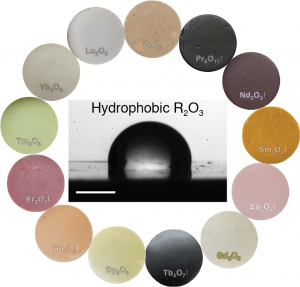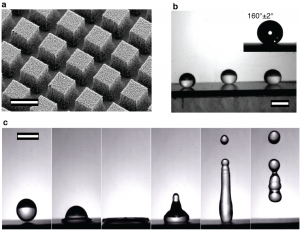Hydrophobic Rare-earth Oxide Ceramics with Applications to Sustained Dropwise Condensation
Hydrophobic materials that are robust to harsh environments are needed in a broad range of applications[1][2][3]. Although durable materials such as metals and ceramics, which are generally hydrophilic, can be rendered hydrophobic by polymeric modifiers[4], these materials deteriorate in harsh environments. Here we show that a class of ceramics comprising the entire lanthanide oxide series, ranging from ceria to lutecia, is intrinsically hydrophobic (Figure 1)[5]. We attribute their hydrophobicity to their unique electronic structure, which inhibits hydrogen bonding with interfacial water molecules. We also show with surface-energy measurements that polar interactions are minimized at these surfaces and with FTIR/GATR that interfacial water molecules are oriented in the hydrophobic hydration structure. Moreover, we demonstrate that these ceramic materials promote dropwise condensation, repel impinging water droplets, and sustain hydrophobicity even after exposure to harsh environments[5]. These ceramics can also be used to fabricate superhydrophobic surfaces using various techniques. As an example, we fabricated superhydrophobic surfaces by sputtering a thin layer (~200-350 nm) of ceria onto nanograss-covered silicon microposts (Figure 2a). Water droplets display high contact angles (Figure 2b) and exhibit extreme mobility due to low contact angle hysteresis (<10°) on these surfaces. In addition, impinging water droplets completely bounce off the surface, leaving it dry (Figure 2c). Hence, we envision that this class of robust hydrophobic materials will have far-reaching technological potential in various industrial applications, where water repellency and dropwise condensation are desirable.
- Figure 1: Photographs of the sintered rare-earth oxide pellets (cerium oxide through lutetium oxide). All the pellets are hydrophobic: water contact angles range between 100° and 115°. The image at the center is a goniometer snapshot of a water droplet beading up on a smooth neodymium oxide surface, as a model sample of the entire REO series; scale bar is 1 mm.
- Figure 2: Superhydrophobicity and water repellency of rare-earth oxide coated textured surfaces. a) SEM of nanograss-covered microposts (side ~ 10 μm, inter-post spacing ~ 5 μm); scale bar is 10 μm; b) Photographs of water droplets on the ceria sputtered nanograss micropost surface (θ =160° ± 2°); scale bar is 2.5 mm.; c) High-speed photography images of a water droplet bouncing off the surface (impact velocity ~ 1.6 m/s); scale bar is 2.5 mm.
- D. Quéré, “Non-sticking drops,” Reports on Progress in Physics, vol. 68, no. 11, pp. 2495–2532, Nov. 2005. [↩]
- L. Bocquet and E. Lauga, “A smooth future?” Nature Materials, vol. 10, no. 5, pp. 334–337, May 2011. [↩]
- D. Quéré, “Wetting and roughness,” Annual Review of Materials Research, vol. 38, pp. 71–99, July 2008. [↩]
- K. Liu and L. Jiang, “Metallic surfaces with special wettability,” Nanoscale, vol. 3, no. 3, pp. 825–838, Mar. 2011. [↩]
- G. Azimi, R. Dhiman, H. Kwon, A. T. Paxson and K. K. Varanasi, “Hydrophobicity of rare-earth oxide ceramics,” Nature Materials, vol. 12, no. 4, pp. 315–320, Apr. 2013. [↩] [↩]

